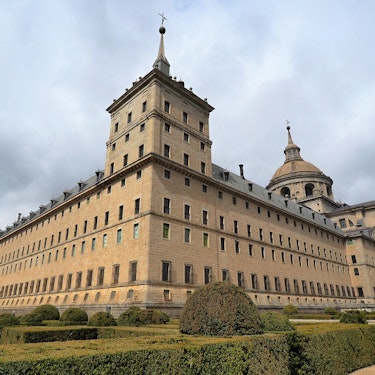More about: Things to Do in El Escorial
To visit the Spanish capital it is necessary to plan very well what you are going to do each day. When you are doing so, I advise you not only to include everything Madrid has to offer, but also to look at some nearby must-see places.
If there is an excursion from Madrid that can be cataloged as a must that is the one that leads to El Escorial. Keep in mind that, although we usually use that name to refer to the monastery, in the area there are two different villages. Thus, attached to each other, are San Lorenzo del Escorial (where the monastery is) and El Escorial, in the lower part. In this article I present everything you can see in the monastery, but also some interesting elements outside the monastery.
1. Courtyard of the Kings

The first thing you will see when you enter the main gate of the monastery complex is the courtyard of the Kings, from which you will have a great view of the facade of the basilica. From this point you will begin your visit, either on your own or with one of the tours that show you around El Escorial.
The most striking thing about it are the six statues representing the kings of the tribes of Judah, placed in this courtyard for having participated in the construction of the Temple of Jerusalem.
2. Palace of the Austrias

One of the most important buildings within the monastery complex is the Palace of the Austrias, also called the House of Philip II, since this king used it as an occasional residence, as did the rest of the monarchs of the House of Austria.
Its interior, as you can see, is quite austere, although it contains some really interesting rooms. Likewise, you should not miss the marquetry doors, the painting Landscape with St. Christopher and Child and the portraits of the Habsburgs.
Hall of Battles
The Hall of Battles, known until the seventeenth century as the King's Gallery, is one of the most impressive you can see in the palace of the Habsburgs. In fact, part of its purpose was to impress the monarch's visitors with frescoes depicting great Spanish military triumphs.
These frescoes, created at the end of the 16th century by the Genoese Nicolás Granello, Fabrizio Castello and Lazaro Tavarone, cover the walls of the hall as if they were tapestries. In them can be seen images of battles such as Higueruela (in 1431), San Quintín (in 1557 and whose victory was honored with the construction of the monastery) or the annexation of Portugal, among others.
The Hall of the Guards
Still inside the palace it is worthwhile to peek into the Hall of the Guards. Here you will find the chair-litter that was used to carry Philip II from Madrid to El Escorial before he died of gout.
In addition, you can also see some interesting paintings of the Flemish schools of the sixteenth and seventeenth centuries and others of other European schools of the time. As a curiosity, the window of the room occupied by the king communicated with the basilica so that he could hear the mass every day.
3. Royal Palace of the Bourbons

The entrance to El Escorial also includes a visit to the Royal Palace of the Bourbons. The first thing you will notice if you have entered the Habsburg Palace before, is the stylistic change that brought with it the change of the reigning house.
The first kings of the House of Bourbon, according to their origins, opted for a more French style in the decoration. This can be seen in the most important rooms of this area: the Queen's Oratory, the King's Hall and the Ambassadors' Hall.
On the other hand, in the Royal Palace you will be able to contemplate many tapestries, including some by Francisco de Goya.
4. The Pantheon of the Kings

One of the pretensions at the time of building the monastery was that it would serve as a resting place for the mortal remains of the Spanish kings. The site chosen was this pantheon, located under the main altar of the basilica.
In this large circular room, built in marble and with a great height, are the remains of 26 kings and queens of the country. The former are placed on the right side of the altar, while the latter were buried on the left side.
At the time of burial here, the bodies had to spend several years in a nearby room, called the Pudridero.
5. The Pantheon of Infantes

Not only kings were buried in this place. Some princes were also buried in the monastery, in the so-called Pantheon of the Princes. It was Queen Isabel II, around 1888, who ordered the construction of this room under the sacristy.
The 9 chambers into which the pantheon is divided contain several really interesting sculptures, as well as several decorative motifs typical of the 19th century.
Right next to this pantheon is another more macabre one: that of the Párvulos. Here were buried the infants who died before reaching puberty, a total of 60.
6. The Chapter Rooms

If you have already visited the Prado Museum, when you enter this part of the monastery you will be able to recognize works by some of the masters of universal painting. These rooms were originally the place where the monks met, but today they house an impressive collection of paintings by Bosch, Zurbaran, Titian and Tintoretto.
As if this were not enough, Diego de Velázquez participated in the decoration of the 9 rooms that make up the area.
It is also worth contemplating the architecture of the rooms. Its vaults, for example, are decorated with beautiful Renaissance frescoes, all of a religious nature.
7. Courtyard of the Evangelists

Another of the most important areas of the complex is the Patio de los Evangelistas. From here you will be able to enjoy a fantastic view of the facades of the cloister galleries and a small temple, called the Temple of the Evangelists, which gives its name to the courtyard created by Juan de Herrera.
The patio, in reality a garden, has the typical form of these interior spaces in the cloisters. With a cross plan, the templete represents the spiritual life and the garden of Eden, with the four rivers that irrigate each zone of the world.
Around the courtyard you can walk through the galleries of the main cloister. In them you can contemplate no less than fifty-four fresco paintings that tell the story of the Redemption. If you follow the order (starting from the Door of the Processions, which leads from the cloister to the church) you will see from the birth of the Virgin to the Last Judgment.
8. Central Staircase

Although it may seem strange, no visit to the monastery of El Escorial can skip contemplating this staircase located in the center of the west gallery of the cloister.
The reason is none other than its fabulous architecture, which is joined by a vault frescoed by Luca Giordano in 1692, whose title is quite explicit: The Glory of the Spanish monarchy.
The ceiling above the staircase also houses other frescoes, these with varied motifs and of different dates. Some of them represent religious events, such as the life of Jesus Christ, while others are dedicated to events such as the battle of San Quentin or the construction of the monastery itself.
9. The Basilica

As it could not be less in an era marked by the importance of the Catholic religion, the basilica of the monastery is one of the most important parts of the complex. Its construction began in 1575, but it was not consecrated until 1586.
To reach it you will have to cross the courtyard of the Kings, decorated with six statues of the kings of Judah who participated in the construction of Solomon's temple.
Once in the basilica, as your guide will explain if you have decided to have one, you will realize that, in reality, two different churches coexist inside it: the Sotocorro, intended for the ceremonies attended by the people, and the Royal Chapel and convent church.
The height of the basilica reaches 95 meters at its highest point. As it happens in great part of the complex, the architecture is quite sober and, in this case, the decoration is very scarce. The only outstanding feature is the sculpture of Jesus Christ Crucified, a work by Cellini, located in one of the chapels.
10. The Library

Book lovers will be impressed when they enter this great library, both for the books it houses and for the wonderful frescoes in its vault.
It is said that Philip II was a great collector of books and relics. In 1612, an edict of his ordered that his library at El Escorial should have a copy of every book published, which gives an idea of what his collection must have been like.
Today, the library houses some 40,000 copies, among which are some gems such as the Cantigas de Alfonso X El Sabio (Canticles of Alfonso X the Wise).
On the other hand, the bookshelves, designed by Juan de Herrera with oak, mahogany and cedar wood, are also worth a look.
11. Garden of the Friars

Outside the monastery is the Jardín de los Frailes, a really quiet and well-kept area. If you have time, I recommend that you take a walk along its paths and look out to contemplate the west side of the monumental complex.
On the east side of the monument there are other gardens similar to the friars. If you look out, you will see that these were separated by walls with niches, as they were intended only for the enjoyment of royalty.
12. The Chair of Philip II

If among all the ways to get to El Escorial from Madrid you have chosen your own car, it will be very easy to get to the Silla de Felipe II If not, you can take a two and a half kilometer walk from the town to get there.
According to legend, the monarch himself used to go to this viewpoint to observe how the monastery works were progressing. Today, it is possibly one of the best places from which to enjoy all the grandeur of the monument.
The Silla de Felipe II is composed of several platforms shaped like steps and seats carved in granite, where you can sit to contemplate the views.
In addition to the impressive views, the route to reach the Silla is really great, to the point that it has become one of the most traveled by hiking enthusiasts who come from the capital.
Those who go by car can leave it in a parking lot located in the Bosque de la Herrería, an area full of oak and chestnut trees. From there, the path to the Silla de Felipe II is really beautiful.
13 Casita del Príncipe

Another visit, only with a guide, that can be made in the area is the Casita del Príncipe. Located in an 18th century palace (10 minutes walk from the monastery) it was used by the kings as a country house.
My advice is to at least take a walk through its gardens, as they house a pond, waterfalls and offer great views of the monastery. In addition, they are free to enter.
14. Royal Theater Coliseum of Carlos III

It is very possible that you will want to stay for lunch in town after seeing the monastery (here are some of the best restaurants in El Escorial). While you are here, you should not miss a walk along the beautiful Floridablanca street, where you will be able to see some interesting buildings.
Perhaps the most worthwhile is the Teatro Real Coliseo de Carlos III. It was this monarch who ordered the theater to be built so that the Royal Sites would have spaces for theatrical performances.
The building is the only theater in the country that preserves the style of the eighteenth century, besides being one of the oldest in Spain. If you are interested in its history, inside there is a museum that shows more than two and a half centuries of history.

















